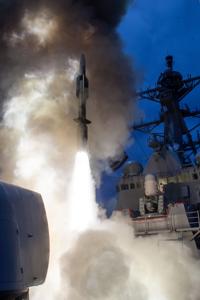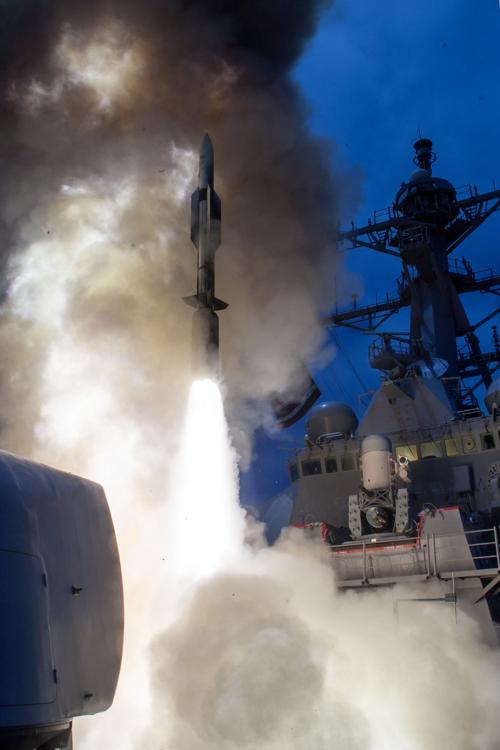A naval missile made by Tucson-based Raytheon Missile Systems destroyed a missile target in the longest surface-to-air intercept of its kind, the company and the U.S. Navy said Friday.
In a test at the Point Mugu Test Range off the California coast on Sept. 22, a Raytheon Standard Missile-6 was launched by the guided missile cruiser USS Princeton and successfully destroyed an “over-the-horizon” threat target using targeting data from a remote, airborne sensor.
The distance of the intercept was not disclosed, but Raytheon said it broke the previous long-range intercept record in January of this year — a milestone the company set itself in 2014.
First deployed by the Navy in 2013, the supersonic SM-6 was developed from the SM-2 series of ship-defense missiles to counter longer-range threats from manned and unmanned fixed-wing aircraft, helicopters, cruise missiles and ballistic missiles in their final phase of flight. In March, the Navy awarded Raytheon a $275 million contract for SM-6 production.
The SM-6’s range is classified but it is believed to be more than 200 miles, based on the range of a predecessor variant and comments from Pentagon officials.
Raytheon said the mission tested the Navy’s ongoing effort to link ships and airborne sensors into a single network. The SM-6 also can use its own active radar to guide itself toward the end of an intercept.
The SM-6 is being developed as a multi-mission weapon, with the additional capability to hit surface targets.
In January, a modified SM-6 fired from a guided missile destroyer sank a decommissioned Navy frigate in a test off Hawaii.
“The multi-mission SM-6 is in a class of its own as it demonstrates its ability to go further, faster and counter more threats to offer maximum mission flexibility,” Mike Campisi, Standard Missile-6 senior program director for Raytheon Missile Systems, said in prepared remarks.
Rear Adm. Jon Hill, who commands the Navy’s Integrated Warfare Systems program, called the latest SM-6 test a significant accomplishment “that will shape the future of surface warfare.”
The SM-6 offers greater range for defense against airborne threats than its predecessor SM-2 or Raytheon’s medium-range Evolved Sea Sparrow Missile.
As an anti-ship missile, the SM-6 would augment Boeing’s shorter range, subsonic Harpoon missile, which has been in service with U.S. and allied navies since the 1970s.
There’s a lot going on as the Navy seeks a Harpoon replacement and longer-range options:
- Boeing last year announced it is developing a new, longer-range version of the Harpoon, called the Harpoon Next Generation.
- Raytheon is working with the Norwegian defense firm Kongsberg to manufacture and further develop Kongsberg’s Naval Strike Missile, an anti-ship and surface-attack weapon with a range of about 100 miles.
- Kongsberg and Raytheon also are teaming up on development of a longer-range version, the Joint Strike Missile, to compete as a replacement for the aging Harpoon or to meet the Navy’s longer-range requirement.
- Lockheed Martin is developing the Long Range Anti-Ship Missile, which has a range of more than 500 miles and is based on Lockheed’s Joint Air-to-Surface Standoff Missile, a stealthy, air-launched cruise missile.
- For long-range engagements, Raytheon is working on a seeker upgrade to the Navy’s Tomahawk cruise missile, which has a 1,000-mile range, to allow it to hit moving ships. A Tomahawk fired from a Navy destroyer hit a moving ship target in a test in January 2015.





